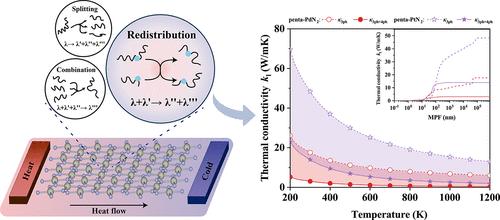揭示四声子散射在五元- xn2 (X = Pd, Pt)单层热输运中的作用:来自第一性原理计算的见解
IF 3.2
3区 化学
Q2 CHEMISTRY, PHYSICAL
引用次数: 0
摘要
理解、准确预测和控制五元二维材料的热输运对于优化其在纳米电子和能源器件中的应用至关重要。为此,我们通过第一性原理计算和四声子(4ph)散射机制系统地阐明了五- xn2 (X = Pd, Pt)单层的热导率调制。与penta-PdN2相比,Penta-PtN2具有更快的声子速度,更弱的非谐波性和更高的固有热导率。加入4ph散射显著降低了整个温度范围内的导热系数,例如,在300 K时,penta-PdN2和penta-PtN2的导热系数分别降低了82%和71%。这种减少主要归因于正常过程的再分配通道,它通过改变声子种群,破坏输运方向性和降低相干性来破坏声子输运。本研究明确了动量守恒下的4ph散射是限制五元- xn2导热性的关键因素,为纳米电子和能源器件中强非调和五元- 2d材料的优化提供了理论指导。本文章由计算机程序翻译,如有差异,请以英文原文为准。

Unveiling the Role of Four-Phonon Scattering in Thermal Transport of Penta-XN2 (X = Pd, Pt) Monolayers: Insights from First-Principles Calculations
Understanding, accurately predicting, and controlling thermal transport in penta-2D materials are crucial for optimizing their applications in nanoelectronics and energy devices. To this end, we systematically elucidate the thermal conductivity modulation in penta-XN2 (X = Pd, Pt) monolayers via first-principles calculations and four-phonon (4ph) scattering mechanisms. Penta-PtN2 exhibits faster acoustic phonon velocities, weaker anharmonicity, and higher intrinsic thermal conductivity compared to penta-PdN2. The inclusion of 4ph scattering significantly reduces thermal conductivity across the entire temperature range, as exemplified by reductions of 82% and 71% for penta-PdN2 and penta-PtN2, respectively, at 300 K. This reduction is primarily attributed to the redistribution channel of the normal process, which disrupts phonon transport by altering phonon populations, breaking transport directionality, and reducing coherence. This study unambiguously identifies the 4ph scattering under momentum conservation as the key factor limiting thermal conductivity in penta-XN2, providing theoretical guidance for optimizing strong anharmonic penta-2D materials in nanoelectronics and energy devices.
求助全文
通过发布文献求助,成功后即可免费获取论文全文。
去求助
来源期刊

The Journal of Physical Chemistry C
化学-材料科学:综合
CiteScore
6.50
自引率
8.10%
发文量
2047
审稿时长
1.8 months
期刊介绍:
The Journal of Physical Chemistry A/B/C is devoted to reporting new and original experimental and theoretical basic research of interest to physical chemists, biophysical chemists, and chemical physicists.
 求助内容:
求助内容: 应助结果提醒方式:
应助结果提醒方式:


